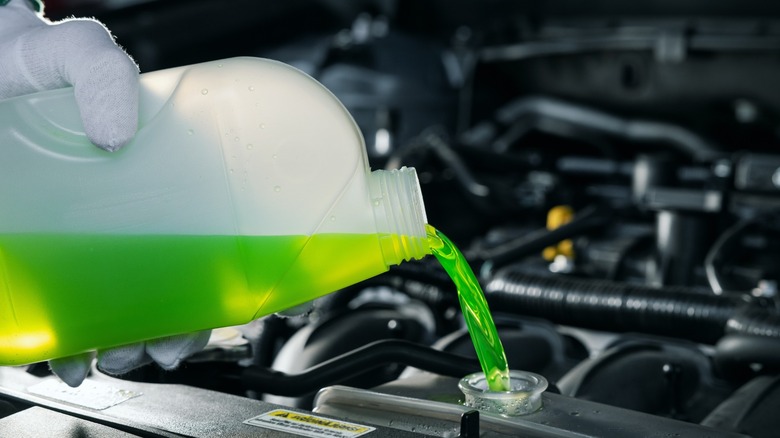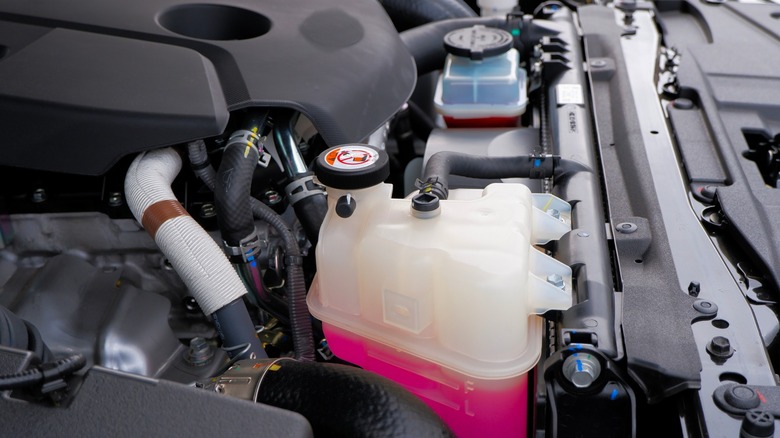Antifreeze Colors Explained (And What Happens If You Mix The Wrong Ones)
Coolant is a 50/50 combination of water and antifreeze. Like motor oil, coolant flows through internal combustion engines to absorb and remove heat, prevent corrosion, and help the motor function at low temperatures. While all vehicles with internal combustion engines use a cooling system filled with coolant, not all cars use the same type of antifreeze and water mixture. If you pop the hood on a Toyota and compare its coolant reservoir to one from a Chevy, you'll notice both containers are filled with different colored liquids. Standard coolant colors include blue, green, orange, pink, and red, but you may also encounter purple and yellow coolants.
At one time, different colors were used to differentiate between the different types of antifreeze found in various coolants. Antifreeze made using inorganic additive technology (IAT) was blue or green, while extended life coolants (ELCs) were orange or red. The colors were especially helpful to DIYers without access to a repair guide or owner's manual, as coolant color was a reliable indicator of the type of antifreeze filling their vehicle. Nowadays, however, coolant color has more to do with the manufacturer than the type of antifreeze it contains.
Since coolant color is no longer a reliable indicator of antifreeze type, drivers cannot rely on color when purchasing coolant for their cars. Each engine is designed for a specific type of antifreeze and water mixture, and mixing two different types of coolant can be disastrous for your engine and lead to expensive damage. Because of this, when it comes time to top off your coolant or flush the cooling system, you should consult your owner's manual to ensure that you're buying the proper product for your car.
What's the difference between different coolant colors?
Modern coolant colors aren't meaningless, but they also don't tell us much about the actual liquid. Different automakers and automotive fluid suppliers use various colors when it comes to coolant. Toyota's original equipment manufacturer (OEM) coolant, for example, is either red or pink. On the other hand, purple coolant is typically found in German car brands like Audi, Volkswagen, and Porsche. You may even encounter two brands with the same color but different antifreeze solutions. Likewise, you may find two brands with opposite colors that have the same chemical composition.
While the original coolant color code is still in place for some brands, you can't choose your car's coolant based solely on its color. Today, coolant color depends more on the manufacturer than its chemical composition. If your car uses IAT, you should only fill its radiator with IAT coolant. Likewise, if your vehicle takes OAT, you should fill the radiator with quality OAT coolant. The same goes for all of the other various coolant types. Always consult your vehicle owner's manual, a trusted mechanic, or an auto parts store to ensure that you fill your radiator with the proper product.
What happens if you mix different coolants?
Every engine is designed to work best with a specific type of coolant, and mixing different types of antifreeze together can be harmful to your engine. Filling your radiator with both IAT and OAT coolant, for example, can result in the formation of a gel that can clog your engine's cooling system and lead to extensive damage. But what about different coolant colors?
As mentioned, we can no longer rely on coolant colors to tell us whether the liquid consists of IAT, OAT, or any other antifreeze type. That means there's a chance that you can find two brands of OAT coolant with different colors. In that case, mixing the two shouldn't damage your engine. However, it's critical that you confirm the two coolants meet your car's standards — failing to do so could result in your engine overheating and costly damage. Generally speaking, the safest move is to avoid mixing different coolant colors. While you may not have any issues doing so, the risks far outweigh any benefits.
Ultimately, the best move to avoid damaging your engine and the surrounding components is to stick with your manufacturer's recommendation and fill your car with coolant that matches its needs.


